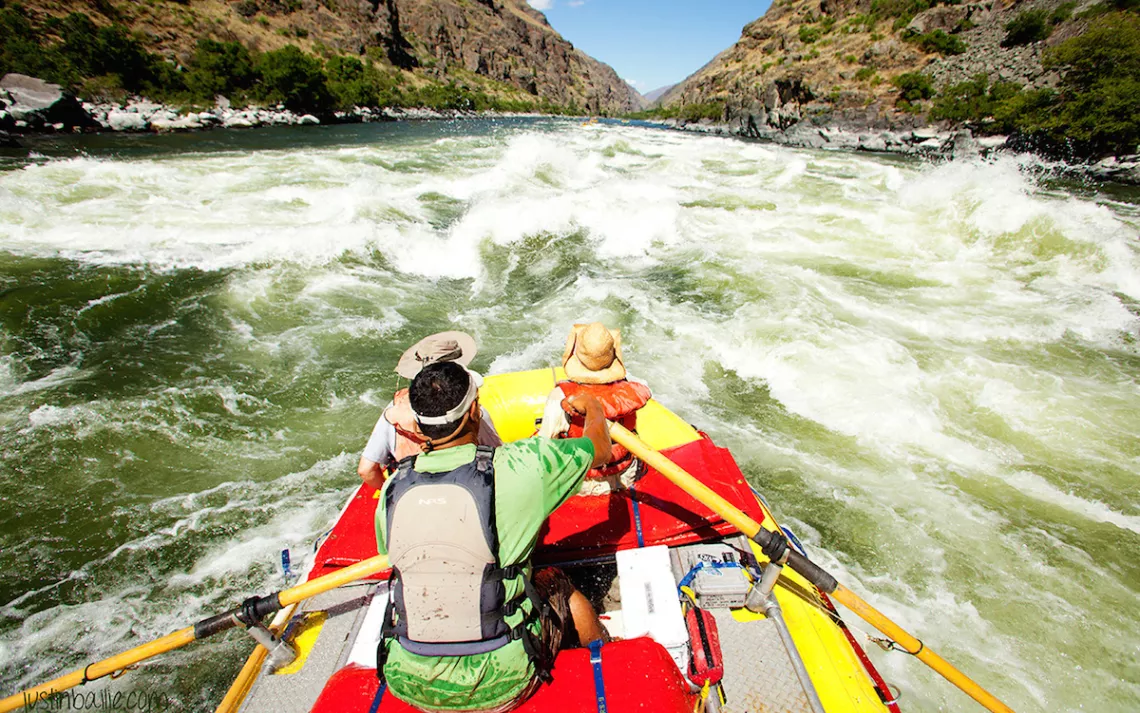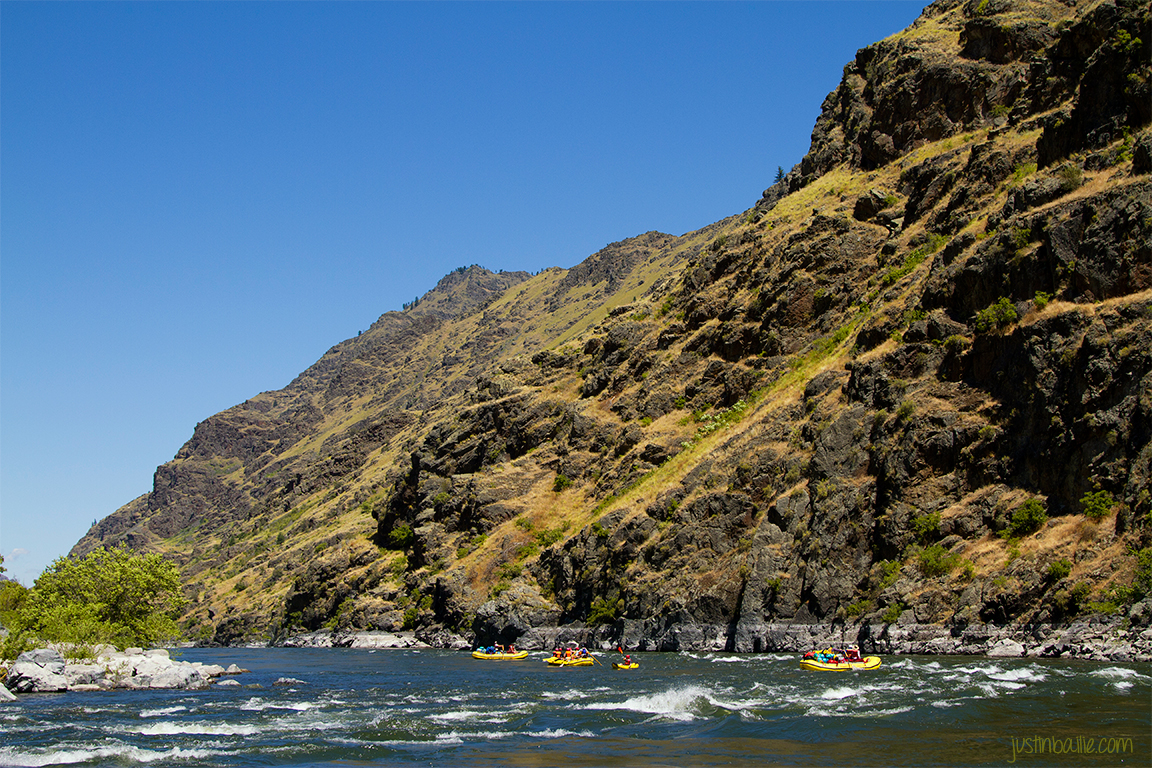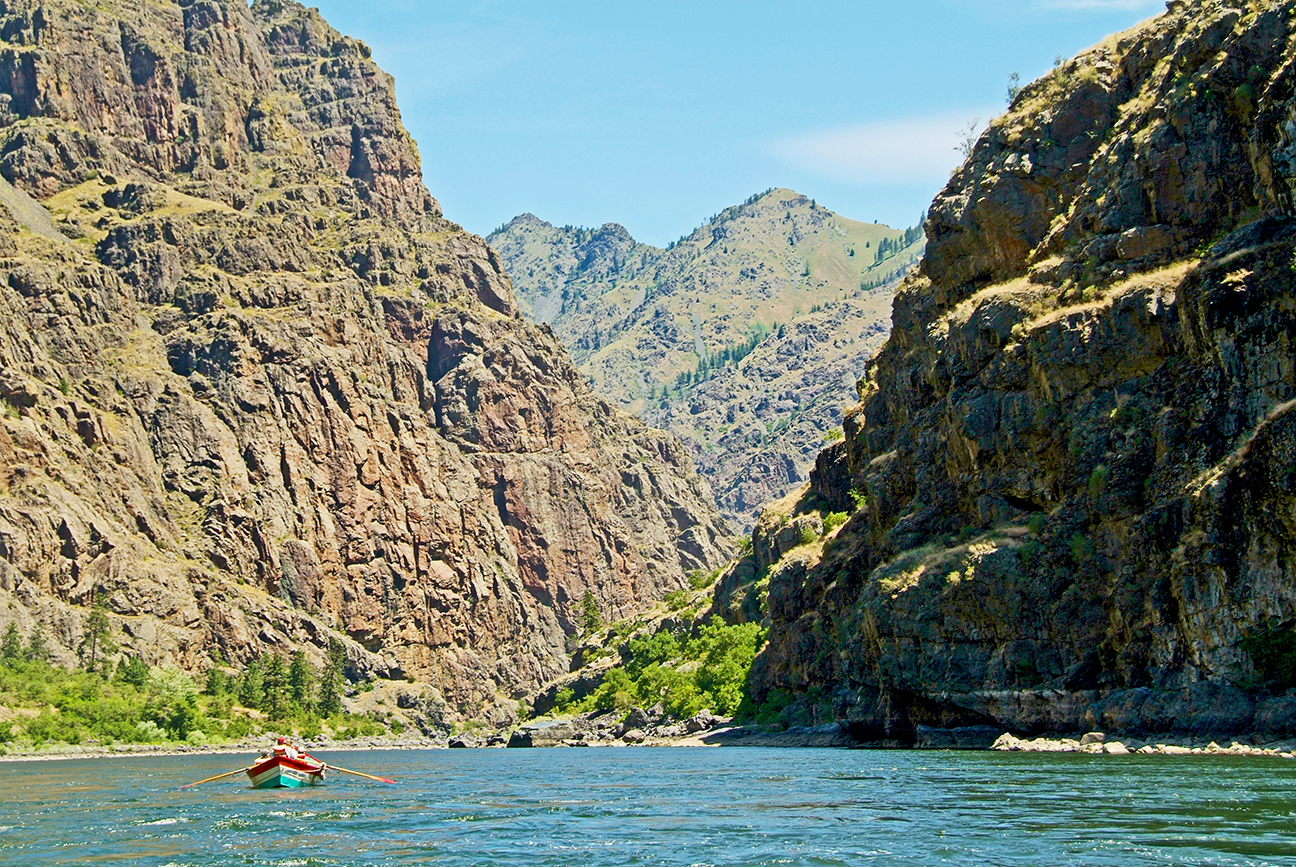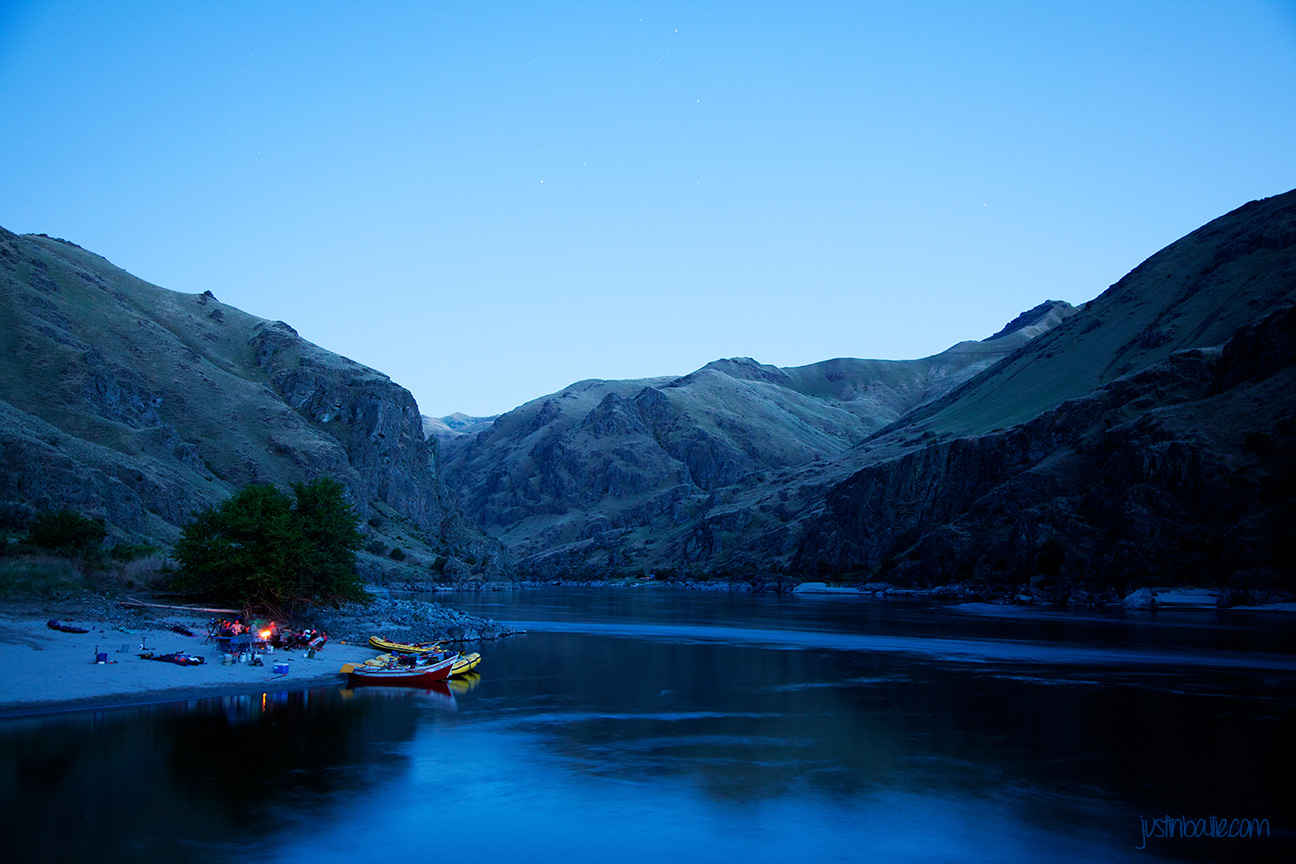Snake River Rafting on the Wild & Scenic River Act’s 50th Anniversary
Hells Canyon is one fitting place to fete the landmark act

Photos courtesy of OARS
I grip the gunwales of the aluminum dory as the boat slides toward our second Class IV rapid of the day. As the bow dips over the ledge and slams into the angry, green wave, I hold tight to keep from launching into the roiling river.
By the time we’re through the next green wave, I’m soaked from several gallons of 50-degree water. We turn back to watch the other four boats in our party disappear into the trough. They each make it through unscathed, along with the waterproof bags containing our sleeping bags, clothing, and food for the next three days. For now, we’re safe from what the guides behind OARS, the conservation-oriented rafting company leading this adventure, call an “unintentional inverted maneuver.”
The body of water I’m now wearing is the Snake River. I’m riding a 30-mile section north through Hells Canyon, the deepest river gorge in North America. Hells Canyon straddles the Oregon-Idaho border, right where Idaho’s Seven Devils Mountains splay their 9,000-foot peaks.
 It’s late May when I visit, and the Hells Canyon Dam, where our journey began, is releasing excess water from spring snowmelt. That abundance of water results in what lead guide and expert dory oarsman Eric Shedd describes as “big yahoo rides.” Shedd is a dynamic, articulate spokesperson for the Snake River. He grew up in the area, and his father was an OARS rafting guide here. “I was born into this,” he says.
It’s late May when I visit, and the Hells Canyon Dam, where our journey began, is releasing excess water from spring snowmelt. That abundance of water results in what lead guide and expert dory oarsman Eric Shedd describes as “big yahoo rides.” Shedd is a dynamic, articulate spokesperson for the Snake River. He grew up in the area, and his father was an OARS rafting guide here. “I was born into this,” he says.
This stretch of the Snake is protected from development thanks to the National Wild and Scenic River Act, which this year is celebrating its 50th anniversary. The act, which President Lyndon B. Johnson signed into law in 1968, formally created the National Wild and Scenic Rivers System, which exists to protect rivers found to “possess outstandingly remarkable scenic, recreational, geologic, fish and wildlife, historic, cultural or other similar value.”
You can read more about the act in Sierra's July/August “Untamed Beauty” feature (page 29). For the purposes of this essay, know that it was spurred by a flurry of river dam building and diversion, along with other forms of development that threatened the wildlife, landscape, and even the drinking water found in these wild places. Congress aimed to balance conservation and dam construction, preserving certain rivers’ “free flowing condition . . . for the benefit and enjoyment of present and future generations.”
The Wild and Scenic Rivers System’s conservation legacy has deep roots in Idaho, where I’m paddling. The bill that started it all was sponsored by Idaho senator Frank Church, who put the law into motion nine years before Johnson inked his signature. Today, the Wild and Scenic Rivers Act protects more than 12,000 miles of 208 rivers in 40 states and Puerto Rico. Rivers can be designated “wild” for their inaccessibility (except by trail) or “scenic” if they’re reachable by road. The section of the Snake we’re rafting, flowing north from Hells Canyon Dam, falls into the “wild” designation. My cellphone signal disappears long before I strap on my life jacket; we won’t see a car for the next three days.
It feels fitting to celebrate the act’s anniversary with OARS, in particular, because as Shedd puts it, “[Oars founder] George Wendt started this company to inspire people to see these wild places and come to love them.” It’s a sentiment that gets right to the heart of the act.
There’s plenty of historical significance within these canyon walls, too. On our second day on the river, we leave the boats tied up on a beach and follow a trail up the steep, red-black walls. Our first visit brings us to a set of Native American pictographs, indecipherable red drawings decorating a slab of rock that’s streaked black from campfires made here centuries ago.
Human habitation has a long history in Hells Canyon, and firm evidence shows that people were here around 7,000 years ago. The river was named for the hand signal the resident Shoshone Indians used to identify themselves, which resembled the movement of a snake.
A short walk away, we step into the McGaffee cabin, a humble 1906 homestead that’s preserved on the National Register of Historic Places, and still strewn with rusting farm equipment.“I like this place because you can see the continuum of people living in this spot,” Shedd notes. “The Native Americans, the homesteaders, and now us with our plastic clothes and propane.”
For this trip’s 15 participants, rafting the Snake is a particularly poignant ode to the spirit of the Wild and Scenic Rivers System, which at least partially intended to create and preserve recreation opportunities like this one. As our group of strangers chats between rapids, or over freshly fried post-dinner churros, I learn that for one couple, going off the grid via whitewater raft is an annual ritual. Their kids are forced to leave their smart devices at home, to trade their screens for bug-hunting and rock-skipping. Here, they don’t seem to miss the inescapable connectivity of modern life.
Whitewater rivers had a formative role in my childhood, too. Growing up in the New Orleans suburbs, the closest thing I got to a rapid was the storm drain in front of our house after a strong rain. There were certainly no mountains, only levees keeping our below-sea-level neighborhood from being inundated by Lake Pontchartrain.
I’d never even seen a mountain until a family trip to the Smokies when I was nine. We rafted the gently flowing Tuckasegee River; I was too little to ride the waves on the burlier Nantahala, as the guides imposed a strict 60-pound weight minimum. I wanted to join my relatives on the raft so badly, I hatched—but didn’t dare execute—a plan to stuff my pockets with rocks.
I thought about the Nantahala for an entire year before we went back again, when I was 10 and finally big enough to ride. There’s some elemental magnetism to all that cold, fresh water, but also something more aesthetic, too: the pull of an adventure in a beautiful place. I have felt that allure ever since.
My adolescence was punctuated with more trips to more turbulent rivers. Our raft suction-cupped itself to a boulder on Clear Creek in Colorado and nearly tossed all the passengers into the drink. I was ejected from a Class V rapid on the American River in California, surfacing beneath the raft. I launched off a boat on the Lower Colorado, along with half of the passengers. We all went down the Class IV feet first, and gasping for air.
There were more, too, though they’re now a white blur in my memory. Sure, my parents also dutifully toted my sister and me to Disney World, but nature’s roller coasters were what made the lasting impressions. These weren’t all official wild and scenic rivers, but they were in spirit.
This isn’t to say I’m not scared of whitewater rafting. Even as an adult, I approach these rivers with a mix of terror and longing. And that’s how on the first day of the Snake River trip, I find myself at the bow seat of Eric Shedd’s dory.
 The dory is like the mechanical bull of the rapids. The inflatable rafts commonly associated with whitewater adventures tend to absorb the waves, while the dory rides elegantly above them, bucking and pitching through every curl in the water. Shedd prefers them because they’re deeply responsive, maneuvering quickly with even the most subtle shifts of his oars. He can row with precision.
The dory is like the mechanical bull of the rapids. The inflatable rafts commonly associated with whitewater adventures tend to absorb the waves, while the dory rides elegantly above them, bucking and pitching through every curl in the water. Shedd prefers them because they’re deeply responsive, maneuvering quickly with even the most subtle shifts of his oars. He can row with precision.
The back of the dory is pretty much the ejector seat, and I can feel the boat’s forward momentum trying to launch me out at every wave. As we catapult through more menacing froth, Shedd lets out a gleeful whoop, and I can’t help but do the same. Our boats gather up in calmer water, so the guides can check in. Each guest is soaked, head to foot, and smiling—the adults’ grins are as wide as the kids’. It’s an Idaho scene that would make Frank Church proud.

Follow in the Writer’s Footsteps
Where: Hells Canyon National Recreation Area, Oregon-Idaho border
Getting there: Because it’s a designated wild and scenic river, the Snake isn’t wholly accessible by car. Popular put-in and take-out points for boaters include Pittsburg Landing, in Idaho off Highway 95, and Hells Canyon Creek, in Oregon off Highway 86.
Best time to visit: Rafting is at its prime in the spring (May and June), when the river is running high and the temperature hasn’t hit summer’s sweltering highs.
Permits: Various permits are required depending on the activity. A full list is available on the National Forest Service website. If you go with a guide service like OARS, they’ll have the required permits.
Wildlife spotting: Wild turkeys, deer, black bears, cougars, elk, mountain goats, chukars, and bighorn sheep are common in Hells Canyon.
 The Magazine of The Sierra Club
The Magazine of The Sierra Club



